The wealth gap—it’s the biggest racial issue that nobody is talking about.

It colors the controversy of Detroit filing for bankruptcy. Motown was forever scarred by the 1967 race riots. More than 80 percent of its citizens are African-American, and 36 percent live below the poverty line, according to the Census Bureau.
It went unmentioned during President Obama’s impromptu remarks about the shooting death of Trayvon Martin, after a Florida jury returned with a verdict of not guilty. Obama spoke of the legacy of racism and discrimination that can exist in the criminal justice system, noting the subtle way a woman can clutch her purse when an African-American steps into an elevator. The president ended his comments with a sense of hope.
“I don't want us to lose sight that things are getting better,” Obama said. “Each successive generation seems to be making progress in changing attitudes when it comes to race.”
RELATED:GROWING INCOME GAP SEPARATES MORE NEIGHBORHOODS
Attitudes are evolving, but African-Americans have not enjoyed the same level of prosperity as the rest of the country, according to multiple studies. Their net worth has trailed that of white households, creating the kind of inequality that politicians seem reluctant to acknowledge in a post-civil rights era.
Obama was willing to speak
about evidence of bias in the criminal justice system on Friday, yet it remains to be seen as to whether the wealth gap will appear in his upcoming speech on Wednesday about the economy.“People have a hard enough time talking about race,” said Dedrick Muhammad, senior director of economics for the NAACP. “People have a hard time talking about money. And to put those conversations together … Those in the political field have found these are things to generally stay away from. “
This is about cold, hard data, not the subtle biases of a car door being locked when an African-American man—even a future president—walks by. It is an uncomfortable trend for a society that prides itself on becoming colorblind.
The Institute on Assets and Social Policy at Brandeis University tracked 1,700 families between 1984 and 2005. It reported in February that the wealth gap between white and black households had tripled—a $152,000 increase—during that time.
An average African-American family was worth just $5,781 in 1984, while a white family had $90,851 in assets.
By 2009, that exact same African-American was worth $28,500. The white family had accrued a total of $265,000. African-Americans did narrow the size of the gap as a ratio. But in terms of actual dollars, the racial disparity in wealth had reached an eye-popping $236,500.
Several factors contributed to this increase—income, unemployment and education—but home ownership was the dominant force, according to the study.
Compared to an African-American family, a typical white family had an eight-year head start on buying a home. Census figures show that almost 70 percent of whites own their homes, while just 43.4 percent of blacks do. Interestingly, the study found that marriage did not have a “statistically significant impact” on the wealth of African-Americans.
RELATED: THE INCOME GAP--A NEW LOOK AT AN AGE-OLD PROBLEM
The Urban Institute released its own study in April based on a survey of consumer finances by the Federal Reserve. It found that in 2010, whites had an average wealth of $632,000, compared to $103,000 for blacks and Hispanics. At the median, the disparity jumps to eight-to-one.
The Pew Research Center put that gap as high as 20-to-one, based on its own polling.
So, what gives? Even if people are judged on the content of their character, society still tends to value the size of their stock portfolio more.
Part of this stems from decades of racial segregation. Whites are five times more likely to inherit money from their relatives than African-Americans, explained Signe-Mary McKernan, a senior fellow at the Urban Institute and co-author of the study. This amounts to a tremendous advantage in paying for college or making a down payment.
The irony is that much of this difference—already entwined with slavery—snowballed after 1945.
“We do know that there is this legacy of discrimination,” said McKernan. “The GI Bill was a huge wealth building mechanism after World War II. It was a terrific bill. But many African-American veterans were denied home and business loans. We gave this big boost that really helped wealth building in this country, but many African-Americans were denied admission.”
The question remains at to when, if ever, the gap will close.
McKernan noted that current government attempts to help lift people out of poverty deny benefits to families with a few thousand dollars in savings. The social safety net encourages them to spend money, instead of investing it.
The president suggested on Friday that hope rests with younger generations to overcome racial disparities. That might be true on questions of tolerance, but when Gallup asked African-Americans about how satisfied they were with their treatment in U.S. society the most pessimistic answers came from 18 to 34 year-old women.
Almost two-thirds of women in that age bracket described themselves as “dissatisfied,” compared to 52 percent of all African-Americans.
Women aged 18 to 34 were more negative on housing and schools as well. A similar trend applies to Hispanic women. When asked why younger African-American women feel so dissatisfied, Gallup editor-in-chief Frank Newport said he did not know.
“I’m not able to determine from the data,” Newport said.


